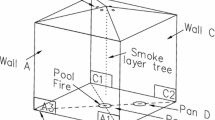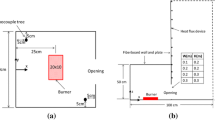Abstract
Validation of physics-based models of fire behavior requires comparing systematically and objectively simulated results and experimental observations in different scenarios, conditions and scales. Heat Release Rate (HRR) is a key parameter for understanding combustion processes in vegetation fires and a main output data of physics-based models. This paper addresses the validation of the Wildland-urban interface Fire Dynamics Simulator (WFDS) through the comparison of predicted and measured values of HRR from spreading fires in a furniture calorimeter. Experimental fuel beds were made up of Pinus pinaster needles and three different fuel loadings (i.e. 0.6, 0.9 and 1.2 kg/m2) were tested under no-slope and up-slope conditions (20°). An Arrhenius type model for solid-phase degradation including char oxidation was implemented in WFDS. To ensure the same experimental and numerical conditions, sensitivity analyses were carried out in order to determine the grid resolution to capture the flow dynamics within the hood of the experimental device and to assess the grid resolution’s influence on the outputs of the model. The comparison of experimental and predicted HRR values showed that WFDS calculates accurately the mean HRR values during the steady-state of fire propagation. It also reproduces correctly the duration of the flaming combustion phase, which is directly tied to the fire rate of spread.



























Similar content being viewed by others
Abbreviations
- A :
-
Pre-exponential factor Arrhenius rate equations
- c p :
-
Specific heat
- dx b :
-
Grid size in the fuel bed
- \( dx_{{{\text{b}}, \delta_{R} /3}} \) :
-
Grid size in the fuel bed computed as a third of the extinction length
- \( dx_{{b, \delta_{R} /5}} \) :
-
Grid size in the fuel bed computed as a fifth of the extinction length
- dx g :
-
Grid size for the reacting flow
- \( dx_{{{\text{g}}, z_{c} min}} \) :
-
Grid size for the reacting flow computed as a sixteenth of z c,line
- \( dx_{{g,z_{c} max}} \) :
-
Grid size for the reacting flow computed as a fourth of \( z_{c,line} \)
- E :
-
Heat released per unit mass of O2 consumed during combustion or activation energy in Arrhenius rate equations divided by the gas constant
- \( F_{{C_{D} }} \) :
-
Drag coefficient factor
- g :
-
Standard gravity
- h b :
-
Fuel bed depth
- h c,e :
-
Convective heat transfer coefficient
- HRR:
-
Heat released rate
- I b :
-
Blackbody radiation intensity
- LSHR:
-
Large Scale Hate Release apparatus (furniture calorimeter)
- M:
-
Fuel moisture content of vegetation (dry basis)
- MLR:
-
Mass loss rate
- \( \dot{n}_{{O_{2} }}^{^\circ } \) :
-
Molar flow rate of O2 in the incoming air
- \( \dot{n}_{{O_{2} }} \) :
-
Molar flow rate of O2 in the exhaust duct
- OCC:
-
Oxygen consumption calorimetry
- \( \dot{q} \) :
-
Heat release rate of the fire
- \( \dot{q}^{\prime} \) :
-
Fire line intensity
- \( \dot{q}_{c,b}^{\prime \prime \prime } \) :
-
Convective heat source
- \( \dot{q}_{r,b}^{\prime \prime } \) :
-
Radiative heat source
- r :
-
Radius
- R:
-
Reaction rate
- Re:
-
Reynolds number
- RH:
-
Relative humidity
- std:
-
Standard deviation
- T :
-
Temperature
- \( \varvec{u} \) :
-
Velocity vector
- U :
-
Integrated radiation intensity
- V:
-
Volume
- Veg :
-
Vegetation
- \( W_{{O_{2} }} \) :
-
Molecular weight of O2
- Y:
-
Mass fraction
- \( z_{c} \) :
-
Characteristic diameter of a fire defined by means of the heat release rate
- \( z_{c,line} \) :
-
Characteristic length scale of a line fire defined by means of the fire line intensity
- α char :
-
Fraction of the energy produced by the char combustion reaction that is deposited in the solid phase
- α e :
-
Volume fraction of the solid-phase
- β char :
-
Constant in char oxidation rate equation
- β e :
-
Packing ratio
- δ R :
-
Extinction length
- κ :
-
Radiative absorption coefficient
- \( \Delta h_{c} \) :
-
Mass-based heat of combustion
- \( \Delta h_{char} \) :
-
Heat of char oxidation
- \( \Delta h_{pyr} \) :
-
Heat of pyrolysis
- \( \Delta h_{vap} \) :
-
Heat of vaporization
- μ :
-
Dynamic viscosity of the gaseous mixture
- \( \nu_{{O_{2} ,char}} \) :
-
Stoichiometric constant for char oxidation
- ρ :
-
Mass density
- σ e :
-
Surface-to-volume ratio for fuel elements
- χ ash :
-
Fraction of char converted to ash
- χ char :
-
Fraction of the dry vegetation converted to char
- χ r :
-
Fraction of local chemical heat release radiated to surroundings
- χ s :
-
Fraction of consumed fuel mass converted to soot
- a :
-
Ambient
- ash :
-
Ash residue from combustion
- b :
-
Bulk quantity
- char :
-
Char oxidation
- CO 2 :
-
Carbon dioxide
- dry :
-
Dry vegetation
- e :
-
Fuel element type
- F :
-
Fuel vapor
- g :
-
Gaseous mixture or gas-phase
- H 2 O :
-
Water vapor
- O 2 :
-
Oxygen
- pyr :
-
Pyrolysis
References
Morvan D (2011) physical phenomena and length scales governing the behaviour of wildfires: a case for physical modelling. Fire Technol 47:437–460
Alexander M and Cruz MG (2013) Are the applications of wildland fire behavior models getting ahead of the evaluation again?. Environ Modell Softw 41:65–71
Babrauskas V, Peacock RD (1992) Heat release rate: the single most important variable in fire hasard. Fire Saf J 18:225–292
Fites JA, Henson C (2004) Real-time evaluation of effects of fuel treatments and other previous land management activities on fire behavior during wildfires. Report of the Joint fires science rapid response project. US Forest Service, pp 1–13
McAthur AG (1962) Control burning in eucalypt forests. Comm. Aust. For. Timb. Bur. Leafl. No. 80
Hammil KA, Bradstock RA (2006) Remote sensing of fire severity in Blue Mountains: influence of vegetation type and inferring fire intensity. Int J Wildland Fire 15:213–26
Sullivan AL, Ball R (2012) Thermal decomposition and combustion chemistry of cellulosic biomass. Atmos Environ 47:133–141
Mell WE, Jenkins MA, Gould J, Cheney P (2007) A physics-based approach to modelling grassland fires. Int J Wildland 16:1–22
Mell WE, Maranghides A, McDermott R, Manzello S (2009) Numerical simulation and experiments of burning Douglas fir trees. Combust Flame 156:2023–2041
Morandini F, Pérez-Ramirez Y, Tihay V, Santoni PA, Barboni T (2013) Global heat release, radiant and convective characterization of fires spreading across forest beds of fuel. Int J Therm Sci 70:83–91
Santoni PA, Morandini F, Barboni T (2011) Determination of fireline intensity by oxygen consumption calorimetry. J Therm Anal Calorim 104:1005–1015
Parker WJ (1982) Calculations of the heat release rate by oxygen consumption for various applications. NBSIR 81–2427–1.
Tihay V, Morandini F, Santoni PA, Pérez-Ramirez Y, Barboni T (2014) Combustion of forest fuel beds under slope conditions: burning rate, heat release rate, convective and radiant fractions for different loads. Combust Flame 161(12):3237–3248
McGrattan K, Hostikka S, McDermott R, Floyd J, Weinschenk C, Overholt K (2013) Fire Dynamics Simulator User’s Guide. Technical Report NIST Special Publication, 1019-6, National Institute of Standards and Technology, Gaithersburg, Maryland.
Overholt KJ, Kurzawski AJ, Cabrera J, Koopersmith M, Ezekoye OA (2014) Fire behavior and heat fluxes for lab-scale burning of little bluestem grass. Fire Saf J 67:70–81
Overholt KJ, Cabrera J, Kurzawski A, Koopersmith M, Ezekoye OA (2014) Characterization of fuel properties and fire spread rates for little bluestem grass. Fire Technol 50(1):9–38
Castle D (2015) Numerical modeling of laboratory-scale surface-to-crown fire transition. M.S. Thesis, San Diego State University, California, USA.
Mueller E, Mell W, Simeoni A (2014) Large eddy simulation of forest canopy flow for wildland fire modeling. Can J For Res 44:1534–1544
Buffachi P, Krieger GC, Mell W, Alvarado E, Santos JE, Carvalho JA (2016) Numerical simulation of surface fires in Brazilian Amazon. Fire Saf J 79:44–56
Hoffman CM, Canfield J, Linn RR, Mell W, Sieg CH, Pimont F, Ziegler J (2016) Evaluating crown fire rate of spread predictions from physics-based models. Fire Technol 52 (1):221–237
Porterie B, Consalvi JL, Kaiss A, Loraud JC (2005) Predicting wildland fire behavior and emissions using a fine-scale physical model. Numer Heat Transf A Appl 47:571–591
Morvan D and Dupuy JL (2001) Modeling of fire spread through a forest fuel bed using a multiphase formulation. Combust Flame 127:1981–1994
El Houssami M, Thomas JC, Lamorlette A, Morvan D, Chaos M, Hadden R, Simeoni A (2016) Experimental and numerical studies characterizing the burning dynamics of wildland fuels. Combust Flame 168:113–126
Dahale A, Ferguson S, Shotorban B, Mahalingam S (2013) Effects of distribution of bulk density and moisture content on shrub fires. Int J Wildland Fire 22:625–641
Porterie B, Morvan D, Larini M Loraud JC (1998) Wildfire propagation: a two dimensional multiphase approach. Combust Explos Shock Waves 34(1):139–150
Lautenberger C and Fernandez-Pello C (2009) A model for the oxidative pyrolysis of wood. Combust Flame 156:1503–1513
Park WC, Atreya A, Baum HR (2010) Experimental and theoretical investigation of heat and mass transfer processes during wood pyrolysis. Combust Flame 157(3):481–494
Ritchie SJ, Steckler KD, Hamins A, Cleary TG, Yang JC, Kashiwagi T (1997) The effect of sample size on the heat release rate of charring materials. Fire Saf Sci 5:177–188
Pérez-Ramirez Y, Santoni PA, Tramoni JB, Mell WE (2014) Numerical simulations of spreading fires in a large-scale calorimeter: The influence of the experimental configuration. In Viegas DX (Ed): Proceedings of the VII International Conference on Forest Fires Research
Forney GP (2012) Smokeview (Version 6)—A Tool for Visualizing Fire Dynamics Simulation Data. Volume I: User’s Guide. NIST Special Publication 1017-1. National Institute of Standards and Technology, Gaithersburg, Maryland
Zaida TJ (2012) Etude expérimentale et numérique de la dégradation thermique des lits combustibles végétaux. PhD Thesis. University of Oaugadougou—Université de Poitiers (Laboratoire de Physique Chimie et de l’Environnement)
Moro C (2006) Détermination des caractéristiques physique de particules de quelques espèces forestières méditerranéennes, INRA PIF2006-06
Quintiere JG, Grove BS (1998) A unified analysis for fire plumes. In: Twenty Seventh Symposium (International) on Combustion. The Combustion Institute 2757–2766
Acknowledgments
This work was partly supported by the HPC Center of Champagne-Ardenne ROMEO, CINES (Centre Informatique National de l’Enseignement Supérieur) and the University of Corsica.
Author information
Authors and Affiliations
Corresponding author
Rights and permissions
About this article
Cite this article
Perez-Ramirez, Y., Mell, W.E., Santoni, P.A. et al. Examination of WFDS in Modeling Spreading Fires in a Furniture Calorimeter. Fire Technol 53, 1795–1832 (2017). https://doi.org/10.1007/s10694-017-0657-z
Received:
Accepted:
Published:
Issue Date:
DOI: https://doi.org/10.1007/s10694-017-0657-z




